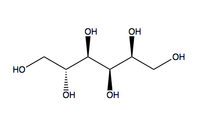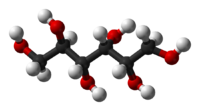Sorbitol
| Sorbitol | |
|---|---|
 |
|
 |
|
|
(2S,3R,4R,5R)-Hexane-1,2,3,4,5,6-hexol
|
|
|
Other names
D-glucitol
D-Sorbitol |
|
| Identifiers | |
| CAS number | 50-70-4 |
| PubChem | 82170 |
| MeSH | Sorbitol |
|
SMILES
O[C@H]([C@H](O)CO)[C@H](O)[C@@H](O)CO
|
|
| Properties | |
| Molecular formula | C6H14O6 |
| Molar mass | 182.17 g mol−1 |
| Density | 1.489 g/cm³ |
| Melting point |
95 °C |
| Boiling point |
296 °C |
| Except where noted otherwise, data are given for materials in their standard state (at 25 °C, 100 kPa) |
|
| Infobox references | |
Sorbitol, also known as glucitol, is a sugar alcohol that the human body metabolises slowly. It is obtained by reduction of glucose, changing the aldehyde group to an additional hydroxyl group.
Contents |
Uses
Sweetener
Sorbitol is a sugar substitute. It may be listed under the inactive ingredients listed for some foods and products. Sorbitol is referred to as a nutritive sweetener because it provides dietary energy: 2.6 kilocalories (11 kilojoules) per gram versus the average 4 kilocalories (17 kilojoules) for carbohydrates. It is often used in diet foods (including diet drinks and ice cream), mints, cough syrups, and sugar-free chewing gum.
It also occurs naturally in many stone fruits and berries from trees of the genus Sorbus.[1]
Laxative
Sorbitol can be used as a non-stimulant laxative via an oral suspension or enema. It works by drawing water into the large intestine, thereby stimulating bowel movements.[2] Sorbitol has been determined safe for use by the elderly, although it is not recommended without consultation with a clinician.[3]
Medical applications
Sorbitol is used in bacterial culture media to distinguish Escherichia coli 0154:H7 from most other strains of E. coli .
Sorbitol, combined with kayexalate, helps the body rid itself of excess potassium ions in a hyperkalaemic state.[4] The kayexalate exchanges sodium ions for potassium ions in the bowel, while sorbitol helps to eliminate it.
Health care, food, and cosmetic uses
Sorbitol often is used in modern cosmetics as a humectant and thickener. Sorbitol often is used in mouthwash and toothpaste. Some transparent gels can be made only with sorbitol, as it has a refractive index sufficiently high for transparent formulations.
Sorbitol is used as a cryoprotectant additive (mixed with sucrose and sodium polyphosphates) in the manufacture of surimi, a highly refined fish paste most commonly produced from Alaska (or walleye) pollock (Theragra chalcogramma). It is also used as a humectant in some cigarettes.[5]
Sorbitol sometimes is used as a sweetener and humectant in cookies and other foods that are not identified as "dietary" items.
Medical importance
Even in the absence of dietary sorbitol, cells produce some sorbitol naturally. Aldose reductase is the first enzyme in the sorbitol-aldose reductase pathway[6] responsible for the reduction of glucose to sorbitol, as well as the reduction of galactose to galactitol. Too much sorbitol trapped in retinal cells, the cells of the lens, and the Schwann cells that myelinate peripheral nerves can damage these cells, leading to retinopathy, cataracts and peripheral neuropathy, respectively. Aldose reductase inhibitors, which are substances that prevent or slow the action of aldose reductase, are currently being investigated as a way to prevent or delay these complications, which frequently occur in the setting of long-term hyperglycemia that accompanies poorly-controlled diabetes. It is thought that these agents may help to prevent the accumulation of intracellular sorbitol that leads to cellular damage in diabetics.[7]
Adverse medical effects
Sorbitol also may aggravate irritable bowel syndrome,[8] and similar gastrointestinal conditions, resulting in severe abdominal pain for those affected, even from small amounts ingested.
Overdose effects
Ingesting large amounts of sorbitol can lead to abdominal pain, gas, and mild to severe diarrhea. Sorbitol ingestion of 20 grams (0.7 oz) per day as sugar-free gum has led to severe diarrhea leading to unintended weight loss of 11 kilograms (24 lb) in a woman originally weighing 52 kilograms (110 lb); another patient required hospitalization after habitually consuming 30 grams (1 oz) per day.[9]
Compendial status
- Food Chemical Codex [10]
- European Pharmacopoeia [11] 6.1 [12]
- British Pharmacopoeia 2009 [13]
- Japanese Pharmacopoeia 15
Miscellaneous uses
A mixture of sorbitol and potassium nitrate has found some success as an amateur solid rocket fuel.[14]
Sorbitol is identified as a potential key chemical intermediate[15] from biomass resources. Complete reduction of sorbitol opens the way to alkanes such as hexane, which can be used as a biofuel. Sorbitol itself provides much of the hydrogen required for the transformation.
- 19 C6H14O6 → 13 C6H14 + 36 CO2 + 42 H2O
The above chemical reaction is exothermic; 1.5 mole of sorbitol generates approximately 1 mole of hexane. When hydrogen is co-fed, no carbon dioxide is produced.
See also
- Mannitol
- Mouthwash
- Xylitol
External links
- NIH Diabetes dictionary — see entry on sorbitol
Notes and references
- ↑ Lehninger Principles of Biochemistry, Nelson and Cox, Fourth Edition
- ↑ ACS :: Cancer Drug Guide: sorbitol
- ↑ Lederle FA: Epidemiology of constipation in elderly patients. Drug utilization and cost-containment strategies. Drugs and Ageing 6:465-469, 1995.
- ↑ Rugolotto S, Gruber M, Solano PD, Chini L, Gobbo S, Pecori S (April 2007). "Necrotizing enterocolitis in a 850 gram infant receiving sorbitol-free sodium polystyrene sulfonate (Kayexalate): clinical and histopathologic findings". J Perinatol 27 (4): 247–9. doi:10.1038/sj.jp.7211677. PMID 17377608.
- ↑ Gallaher Group Plc - Ingredients
- ↑ Normalizing mitochondrial superoxide production blocks three pathways of hyperglycaemic damage.
- ↑ Sorbitol: a hazard for diabetics? Nutrition Health Review
- ↑ Irritable Bowel Syndrome: Causes and Treatment - What can aggravate my symptoms?
- ↑ Kathleen Doheny (2008-01-10). "Sweetener Side Effects: Case Histories". WebMD Medical News. http://www.webmd.com/diet/news/20080110/sweetener-side-effects-case-histories. Retrieved 2008-01-10.
- ↑ The United States Pharmacopeial Convention. "Revisions to FCC, First Supplement". http://www.usp.org/fcc/FCC61SBallotResultsWebPostingReport04.html. Retrieved 6 July 2009.
- ↑ Sigma Aldrich. "D-Sorbitol". http://www.sigmaaldrich.com/catalog/ProductDetail.do?lang=en&N4=97336. Retrieved 6 July 2009.
- ↑ European Pharmacopoeia. "Index, Ph Eur". https://www.edqm.eu/store/images/majbdd/200709201618250.6_1%20IndexE.pdf. Retrieved 6 July 2009.
- ↑ British Pharmacopoeia (2009). "Index, BP 2009". http://www.pharmacopoeia.co.uk/pdf/2009_index.pdf. Retrieved 6 July 2009.
- ↑ Richard Nakka's Experimental Rocketry Web Site
- ↑ Production of Liquid Hydrocarbons from Biomass Jürgen O. Metzger Angewandte Chemie International Edition Volume 45, Issue 5 , Pages 696 - 698 2005 link to the publisher
|
||||||||||||||||||||||||||||||||
|
||||||||||||||||||||
|
|||||||||||||||||||||||||||||||||||||||